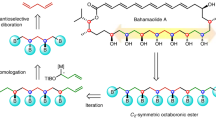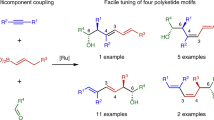Abstract
The polypropionate motif is ubiquitous, being characteristic of the most important family of natural products for human health, the polyketides. Numerous strategies have been devised to construct these molecules with high stereocontrol, but certain stereoisomers remain challenging to prepare. We now describe the development of an iterative assembly line strategy for the construction of polypropionates. An assembly line strategy for the synthesis of deoxypolypropionates has already been described. However, the introduction of carbinol units required the development of new building blocks and new reaction conditions. This has been achieved by the use of enantioenriched lithiated α-chlorosilanes [1-((2′-lithiochloromethyldimethylsilyl)-methyl)-2-(methoxymethyl)-pyrrolidine], thus enabling the programmed synthesis of polypropionates in a fully stereocontrolled manner, including the stereochemically challenging anti–anti isomers. The versatility of the approach is exemplified in its extension to the synthesis of 1,3-related polyols. The methodology now allows access to a much wider family of polyketide natural products with stereochemistry being dialled in at will.
This is a preview of subscription content, access via your institution
Access options
Access Nature and 54 other Nature Portfolio journals
Get Nature+, our best-value online-access subscription
$29.99 / 30 days
cancel any time
Subscribe to this journal
Receive 12 print issues and online access
$259.00 per year
only $21.58 per issue
Buy this article
- Purchase on Springer Link
- Instant access to full article PDF
Prices may be subject to local taxes which are calculated during checkout




Similar content being viewed by others
References
Rohr, J. A new role for polyketides. Angew. Chem. Int. Ed. 39, 2847–2849 (2000).
Koskinen, A. M. P. & Karisalmi, K. Polyketide stereotetrads in natural products. Chem. Soc. Rev. 34, 677–690 (2005).
Hertweck, C. The biosynthetic logic of polyketide diversity. Angew. Chem. Int. Ed. 48, 4688–4716 (2009).
Rimando, A. M. & Baerson, S. R. (eds) Polyketides: Biosynthesis, Biological Activity, and Genetic Engineering (American Chemical Society, 2006).
Weissman, K. J. & Leadlay, P. F. Combinatorial biosynthesis of reduced polyketides. Nat. Rev. Microbiol. 3, 925–936 (2005).
Koehn, F. E. & Carter, G. T. The evolving role of natural products in drug discovery. Nat. Rev. Drug Discov. 4, 206–220 (2005).
Newman, D. J. & Cragg, G. M. Natural products as sources of new drugs over the last 25 years. J. Nat. Prod. 70, 461–477 (2007).
Butler, M. S., Robertson, A. A. B. & Cooper, M. A. Natural product and natural product derived drugs in clinical trials. Nat. Prod. Rep. 31, 1612–1661 (2014).
Omura, S. (ed.) Macrolide Antibiotics. Chemistry, Biology, and Practice (Academic, 2002).
Paterson, I. & Findlay, A. D. Recent advances in the total synthesis of polyketide natural products as promising anticancer agents. Aust. J. Chem. 62, 624–638 (2009).
Hoffmann, R. W. Stereoselective syntheses of building blocks with three consecutive stereogenic centers: important precursors of polyketide natural products. Angew. Chem. Int. Ed. 26, 489–503 (1987).
Li, J. & Menche, D. Direct methods for stereoselective polypropionate synthesis: a survey. Synthesis 2293–2315 (2009).
Schetter, B. & Mahrwald, R. Modern aldol methods for the total synthesis of polyketides. Angew. Chem. Int. Ed. 45, 7506–7525 (2006).
Evans, D. A. et al. Chiral enolate design. Pure Appl. Chem. 53, 1109–1127 (1981).
Dechert-Schmitt, A.-M. R., Schmitt, D. C., Gao, X., Itoh, T. & Krische, M. J. Polyketide construction via hydroxyalkylation and related alcohol C–H functionalizations: reinventing the chemistry of carbonyl addition. Nat. Prod. Rep. 31, 504–513 (2014).
Feng, J., Kasun, Z. A. & Krische, M. J. Enantioselective alcohol C–H functionalization for polyketide construction: unlocking redox-economy and site-selectivity for ideal chemical synthesis. J. Am. Chem. Soc. 138, 5467–5478 (2016).
Chen, M. & Roush, W. R . Highly stereoselective synthesis of anti,anti-dipropionate stereotriads: a solution to the long-standing problem of challenging mismatched double asymmetric crotylboration reactions. J. Am. Chem. Soc. 134, 3925–3931 (2012).
Cheng, B. & Trauner, D. A highly convergent and biomimetic total synthesis of portentol. J. Am. Chem. Soc. 137, 13800–13803 (2015).
Burns, M. et al. Assembly-line synthesis of organic molecules with tailored shapes. Nature 513, 183–188 (2014).
Balieu, S. et al. Toward ideality: the synthesis of (+)-kalkitoxin and (+)-hydroxyphthioceranic acid by assembly-line synthesis. J. Am. Chem. Soc. 137, 4398–4403 (2015).
Sadhu, K. M. & Matteson, D. S. (Chloromethyl)lithium: efficient generation and capture by boronic esters and a simple preparation of diisopropyl (chloromethyl)boronate. Organometallics 4, 1687–1689 (1985).
Xu, S., Li, H., Komiyama, M., Oda, A. & Negishi, E.-i. One-step homologation for the catalytic asymmetric synthesis of deoxypropionates. Chem. Eur. J. 23, 149–156 (2017).
Xu, S. & Negishi, E.-i. Zirconium-catalyzed asymmetric carboalumination of unactivated terminal alkenes. Acc. Chem. Res. 49, 2158–2168 (2016).
Gati, W. & Yamamoto, H. Second generation of aldol reaction. Acc. Chem. Res. 49, 1757–1768 (2016).
Lin, L. et al. Catalytic asymmetric iterative/domino aldehyde cross-aldol reactions for the rapid and flexible synthesis of 1,3-polyols. J. Am. Chem. Soc. 137, 15418–15421 (2015).
Zheng, K., Xie, C. & Hong, R. Bioinspired iterative synthesis of polyketides. Front. Chem. 3, 1–17 (2015).
Matteson, D. S. Functional group compatibilities in boronic ester chemistry. J. Organomet. Chem. 581, 51–65 (1999).
Vedrenne, E., Wallner, O. A., Vitale, M., Schmidt, F. & Aggarwal, V. K. Homologation of boronic esters with lithiated epoxides for the stereocontrolled synthesis of 1,2- and 1,3-diols and 1,2,4-triols. Org. Lett. 11, 165–168 (2009).
Jones, G. R. & Landais, Y. The oxidation of the carbon–silicon bond. Tetrahedron 52, 7599–7662 (1996).
Basu, A. & Thayumanavan, S . Configurational stability and transfer of stereochemical information in the reactions of enantioenriched organolithium reagents. Angew. Chem. Int. Ed. 41, 716–738 (2002).
Hoffmann, R. W., Rühl, T. & Harbach, J. On the configurational stability of α-hetero-substituted benzyllithium compounds. Liebigs Ann. Chem. 1992, 725–730 (1992).
Schweifer, A. & Hammerschmidt, F. Formal and improved synthesis of enantiopure chiral methanol. Tetrahedron 64, 7605–7610 (2008).
Aggarwal, V. K. et al. Asymmetric synthesis of tertiary and quaternary allyl- and crotylsilanes via the borylation of lithiated carbamates. Org. Lett. 13, 1490–1493 (2011).
Barsamian, A. L., Wu, Z. & Blakemore, P. R. Enantioselective synthesis of α-phenyl- and α-(dimethylphenylsilyl)alkylboronic esters by ligand mediated stereoinductive reagent-controlled homologation using configurationally labile carbenoids. Org. Biomol. Chem. 13, 3781–3786 (2015).
Nakamura, S. & Nakagawa, R. Watanabe, Y . & Toru, T. Highly enantioselective reactions of configurationally labile α-thioorganolithiums using chiral bis(oxazoline)s via two different enantiodetermining steps. J. Am. Chem. Soc. 122, 11340–11347 (2000).
Lange, H., Huenerbein, R., Fröhlich, R., Grimme, S. & Hoppe, D . Configurationally labile lithiated O-benzyl carbamates: application in asymmetric synthesis and quantum chemical investigations on the equilibrium of diastereomers. Chem. Asian J. 3, 78–87 (2008).
Chan, T. H. & Pellon, P. Chiral organosilicon compounds in synthesis. Highly enantioselective synthesis of arylcarbinols. J. Am. Chem. Soc. 111, 8737–8738 (1989).
Strohmann, C., Lehmen, K., Wild, K. & Schildbach, D. A highly diastereomerically enriched benzyllithium compound: the molecular structure and the stereochemical course of its transformations. Organometallics 21, 3079–3081 (2002).
Strohmann, C., Buchold, D. H. M., Seibel, T. Wild, K. & Schildbach, D. Syntheses and crystal structures of highly diastereomerically enriched lithiated benzylsilanes in the presence of external donor molecules: experiment and theory. Eur. J. Inorg. Chem. 2003, 3453–3463 (2003).
Bagutski, V., French, R. M. & Aggarwal, V. K. Full chirality transfer in the conversion of secondary alcohols into tertiary boronic esters and alcohols using lithiation–borylation reactions. Angew. Chem. Int. Ed. 49, 5142–5145 (2010).
Evans, D. A., Crawford, T. C., Thomas, R. C. & Walker, J. A. Studies directed toward the synthesis of prostaglandins. Useful boron-mediated olefin syntheses. J. Org. Chem. 41, 3947–3953 (1976).
Tamao, K., Ishida, N., Tanaka, T. & Kumada, M. Hydrogen peroxide oxidation of the silicon–carbon bond in organoalkoxysilanes. Organometallics 2, 1694–1696 (1983).
Stymiest, J. L., Bagutski, V., French, R. M. & Aggarwal, V. K. Enantiodivergent conversion of chiral secondary alcohols into tertiary alcohols. Nature 456, 778–782 (2008).
Leonori, D. & Aggarwal, V. K. Lithiation–borylation methodology and its application in synthesis. Acc. Chem. Res. 47, 3174–3183 (2014).
Bonet, A., Odachowski, M., Leonori, D., Essafi, S. & Aggarwal, V. K. Enantiospecific sp2–sp3 coupling of secondary and tertiary boronic esters. Nat. Chem. 6, 584–589 (2014).
Wang, Y., Noble, A., Myers, E. L. & Aggarwal, V. K. Enantiospecific alkynylation of alkylboronic esters. Angew. Chem. Int. Ed. 55, 4270–4274 (2016).
Hoppe, D . & Hense, T. Enantioselective synthesis with lithium/(−)-sparteine carbanion pairs. Angew. Chem. Int. Ed. 36, 2282–2316 (1997).
Beak, P., Baillargeon, M. & Carter, L. G. Lithiation of ethyl 2,4,6-triisopropylbenzoate adjacent to oxygen: the α-lithioalkyl alcohol synthon. J. Org. Chem. 43, 4255–4256 (1978).
Hoppe, D., Marr, F. & Brüggemann, M. Organolithiums in Enantioselective Synthesis (ed. Hodgson, D. M.) 61–137 (Springer, 2003).
Miyake, Y., Ashida, Y., Nakajima, K. & Nishibayashi, Y. Visible-light-mediated addition of α-aminoalkyl radicals generated from α-silylamines to α,β-unsaturated carbonyl compounds. Chem. Commun. 48, 6966–6968 (2012).
Espelt, L. R., McPherson, I. S., Wiensch, E. M. & Yoon, T. P. Enantioselective conjugate additions of α-amino radicals via cooperative photoredox and Lewis acid catalysis. J. Am. Chem. Soc. 137, 2452–2455 (2015).
Bode, S. E., Wolberg, M. & Müller, M . Stereoselective synthesis of 1,3-diols. Synthesis 557–588 (2006).
Acknowledgements
Thge authors thank the European Research Council (FP7, ERC grant no. 670668), the EPSRC (EP/I038071/1) and Bristol University for financial support. T.B. acknowledges support from the Marie Curie Fellowship programme (EC FP7, no. 626828). The authors thank P.J. Unsworth for discussions and preliminary work.
Author information
Authors and Affiliations
Contributions
V.K.A. and E.L.M. conceived and directed the project. T.B. and J.M.F. conducted and designed the experiments and analysed the data. V.K.A., E.L.M. and T.B. co-wrote the paper.
Corresponding author
Ethics declarations
Competing interests
The authors declare no competing financial interests.
Supplementary information
Supplementary information
Supplementary information (PDF 13859 kb)
Rights and permissions
About this article
Cite this article
Bootwicha, T., Feilner, J., Myers, E. et al. Iterative assembly line synthesis of polypropionates with full stereocontrol. Nature Chem 9, 896–902 (2017). https://doi.org/10.1038/nchem.2757
Received:
Accepted:
Published:
Issue Date:
DOI: https://doi.org/10.1038/nchem.2757
This article is cited by
-
Ni-catalysed assembly of axially chiral alkenes from alkynyl tetracoordinate borons via 1,3-metallate shift
Nature Chemistry (2024)
-
Organogel delivery vehicles for the stabilization of organolithium reagents
Nature Chemistry (2023)
-
Iterative synthesis of 1,3-polyboronic esters with high stereocontrol and application to the synthesis of bahamaolide A
Nature Chemistry (2023)
-
Catalytic length-controlled oligomerization with synthetic programmable templates
Nature Synthesis (2023)
-
Lithiation–borylation methodology in the total synthesis of natural products
Nature Synthesis (2022)



